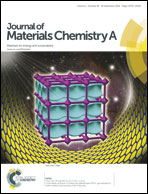Porphyrinic porous organic frameworks: preparation and post-synthetic modification via demetallation–remetallation†
Abstract
We report a systematic synthesis of twelve porphyrinic porous organic frameworks (por-POF-n, n = 1–12) using building blocks with different sizes and connectivities, and we show that as the monomer's size and connectivity increase, the BET surface area and gas uptake capacity of the resulting por-POFs consistently increase, which suggests minimized network interpenetration. Importantly, we demonstrate that the metal center in por-POF-8 can be modified through a post-synthetic demetallation–remetallation process, which provides an excellent opportunity to investigate the effect of the coordinatively unsaturated metal sites on gas adsorption. In particular, demetallated por-POF-8-2H and remetallated por-POF-8-FeCl and por-POF-8-Ni exhibit similar isosteric heats of adsorption (Qst) toward H2 and CO2, which indicates that there is a limited effect of the porphyrin metal center on the gas uptake of por-POFs. This finding is further supported by a density-functional theory (DFT) calculation. The post-synthetically generated por-POF-8-FeCl shows an excellent biomimetic catalytic activity towards the oxidation of pyrogallol, demonstrating the great potentials of highly stable por-POFs as a new class of biomimetic catalysts.


 Please wait while we load your content...
Please wait while we load your content...